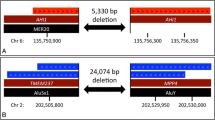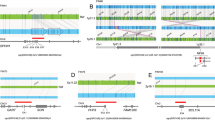Abstract
Exome sequencing (ES) has become the method of choice for diagnosing rare diseases, while the availability of short-read genome sequencing (SR-GS) in a medical setting is increasing. In addition, new sequencing technologies, such as long-read genome sequencing (LR-GS) and transcriptome sequencing, are being increasingly used. However, the contribution of these techniques compared to widely used ES is not well established, particularly in regards to the analysis of non-coding regions. In a pilot study of five probands affected by an undiagnosed neurodevelopmental disorder, we performed trio-based short-read GS and long-read GS as well as case-only peripheral blood transcriptome sequencing. We identified three new genetic diagnoses, none of which affected the coding regions. More specifically, LR-GS identified a balanced inversion in NSD1, highlighting a rare mechanism of Sotos syndrome. SR-GS identified a homozygous deep intronic variant of KLHL7 resulting in a neoexon inclusion, and a de novo mosaic intronic 22-bp deletion in KMT2D, leading to the diagnosis of Perching and Kabuki syndromes, respectively. All three variants had a significant effect on the transcriptome, which showed decreased gene expression, mono-allelic expression and splicing defects, respectively, further validating the effect of these variants. Overall, in undiagnosed patients, the combination of short and long read GS allowed the detection of cryptic variations not or barely detectable by ES, making it a highly sensitive method at the cost of more complex bioinformatics approaches. Transcriptome sequencing is a valuable complement for the functional validation of variations, particularly in the non-coding genome.





Similar content being viewed by others
Data availability
The datasets generated during and/or analysed during the current study are available from the corresponding author on reasonable request.
References
100,000 Genomes Project Pilot Investigators, Smedley D, Smith KR, et al (2021) 100,000 genomes pilot on rare-disease diagnosis in health care—preliminary report. N Engl J Med 385:1868–1880. https://doi.org/10.1056/NEJMoa2035790
Angius A, Uva P, Buers I et al (2016) Bi-allelic mutations in KLHL7 cause a Crisponi/CISS1-like phenotype associated with early-onset retinitis pigmentosa. Am J Hum Genet 99:236–245. https://doi.org/10.1016/j.ajhg.2016.05.026
Baux D, Van Goethem C, Ardouin O et al (2021) MobiDetails: online DNA variants interpretation. Eur J Hum Genet 29:356–360. https://doi.org/10.1038/s41431-020-00755-z
Beyter D, Ingimundardottir H, Oddsson A et al (2021) Long-read sequencing of 3,622 Icelanders provides insight into the role of structural variants in human diseases and other traits. Nat Genet 53:779–786. https://doi.org/10.1038/s41588-021-00865-4
Bruel A-L, Bigoni S, Kennedy J et al (2017) Expanding the clinical spectrum of recessive truncating mutations of KLHL7 to a Bohring-Opitz-like phenotype. J Med Genet 54:830–835. https://doi.org/10.1136/jmedgenet-2017-104748
Clarke J, Wu H-C, Jayasinghe L et al (2009) Continuous base identification for single-molecule nanopore DNA sequencing. Nat Nanotechnol 4:265–270. https://doi.org/10.1038/nnano.2009.12
Colin E, Duffourd Y, Tisserant E et al (2022) OMIXCARE: OMICS technologies solved about 33% of the patients with heterogeneous rare neuro-developmental disorders and negative exome sequencing results and identified 13% additional candidate variants. Front Cell Dev Biol 10:1021785. https://doi.org/10.3389/fcell.2022.1021785
Coursimault J, Cassinari K, Lecoquierre F et al (2022) Deep intronic NIPBL de novo mutations and differential diagnoses revealed by whole genome and RNA sequencing in Cornelia de Lange syndrome patients. Hum Mutat. https://doi.org/10.1002/humu.24438
Danis D, Jacobsen JOB, Balachandran P et al (2022) SvAnna: efficient and accurate pathogenicity prediction of coding and regulatory structural variants in long-read genome sequencing. Genome Med 14:44. https://doi.org/10.1186/s13073-022-01046-6
De Coster W, De Rijk P, De Roeck A et al (2019) Structural variants identified by Oxford Nanopore PromethION sequencing of the human genome. Genome Res 29:1178–1187. https://doi.org/10.1101/gr.244939.118
De Coster W, Weissensteiner MH, Sedlazeck FJ (2021) Towards population-scale long-read sequencing. Nat Rev Genet 22:572–587. https://doi.org/10.1038/s41576-021-00367-3
de Sainte Agathe J-M, Filser M, Isidor B et al (2023) SpliceAI-visual: a free online tool to improve SpliceAI splicing variant interpretation. Hum Genom 17:7. https://doi.org/10.1186/s40246-023-00451-1
Deciphering Developmental Disorders Study (2017) Prevalence and architecture of de novo mutations in developmental disorders. Nature 542:433–438. https://doi.org/10.1038/nature21062
Dong Z, Yan J, Xu F et al (2019) Genome sequencing explores complexity of chromosomal abnormalities in recurrent miscarriage. Am J Hum Genet 105:1102–1111. https://doi.org/10.1016/j.ajhg.2019.10.003
Eid J, Fehr A, Gray J et al (2009) Real-time DNA sequencing from single polymerase molecules. Science 323:133–138. https://doi.org/10.1126/science.1162986
Ellingford JM, Ahn JW, Bagnall RD et al (2022) Recommendations for clinical interpretation of variants found in non-coding regions of the genome. Genome Med 14:73. https://doi.org/10.1186/s13073-022-01073-3
Gilissen C, Hehir-Kwa JY, Thung DT et al (2014) Genome sequencing identifies major causes of severe intellectual disability. Nature 511:344–347. https://doi.org/10.1038/nature13394
Hiatt SM, Lawlor JMJ, Handley LH et al (2021) Long-read genome sequencing for the molecular diagnosis of neurodevelopmental disorders. HGG Adv 2:100023. https://doi.org/10.1016/j.xhgg.2021.100023
Jeffries L, Olivieri JE, Ji W et al (2019) Two siblings with a novel nonsense variant provide further delineation of the spectrum of recessive KLHL7 diseases. Eur J Med Genet 62:103551. https://doi.org/10.1016/j.ejmg.2018.10.003
Kaplanis J, Samocha KE, Wiel L et al (2020) Evidence for 28 genetic disorders discovered by combining healthcare and research data. Nature 586:757–762. https://doi.org/10.1038/s41586-020-2832-5
Köhler S, Schulz MH, Krawitz P et al (2009) Clinical diagnostics in human genetics with semantic similarity searches in ontologies. Am J Hum Genet 85:457–464. https://doi.org/10.1016/j.ajhg.2009.09.003
Kovanda A, Zimani AN, Peterlin B (2021) How to design a national genomic project-a systematic review of active projects. Hum Genom 15:20. https://doi.org/10.1186/s40246-021-00315-6
Latorre-Pellicer A, Gil-Salvador M, Parenti I et al (2021) Clinical relevance of postzygotic mosaicism in Cornelia de Lange syndrome and purifying selection of NIPBL variants in blood. Sci Rep 11:15459. https://doi.org/10.1038/s41598-021-94958-z
Lee H, Huang AY, Wang L-K et al (2020) Diagnostic utility of transcriptome sequencing for rare Mendelian diseases. Genet Med 22:490–499. https://doi.org/10.1038/s41436-019-0672-1
Lévy Y (2016) Genomic medicine 2025: France in the race for precision medicine. Lancet 388:2872. https://doi.org/10.1016/S0140-6736(16)32467-9
Mantere T, Kersten S, Hoischen A (2019) Long-read sequencing emerging in medical genetics. Front Genet 10:426. https://doi.org/10.3389/fgene.2019.00426
Olson ND, Wagner J, McDaniel J et al (2022) PrecisionFDA truth challenge V2: calling variants from short and long reads in difficult-to-map regions. Cell Genom 2:100129. https://doi.org/10.1016/j.xgen.2022.100129
Pauper M, Kucuk E, Wenger AM et al (2021) Long-read trio sequencing of individuals with unsolved intellectual disability. Eur J Hum Genet 29:637–648. https://doi.org/10.1038/s41431-020-00770-0
Poplin R, Chang P-C, Alexander D et al (2018) A universal SNP and small-indel variant caller using deep neural networks. Nat Biotechnol 36:983–987. https://doi.org/10.1038/nbt.4235
Quinodoz M, Peter VG, Bedoni N et al (2021) AutoMap is a high performance homozygosity mapping tool using next-generation sequencing data. Nat Commun 12:518. https://doi.org/10.1038/s41467-020-20584-4
Richards S, Aziz N, Bale S et al (2015) Standards and guidelines for the interpretation of sequence variants: a joint consensus recommendation of the American College of Medical Genetics and Genomics and the Association for Molecular Pathology. Genet Med 17:405–424. https://doi.org/10.1038/gim.2015.30
Souche E, Beltran S, Brosens E et al (2022) Recommendations for whole genome sequencing in diagnostics for rare diseases. Eur J Hum Genet 30:1017–1021. https://doi.org/10.1038/s41431-022-01113-x
van El CG, Cornel MC, Borry P et al (2013) Whole-genome sequencing in health care: recommendations of the European Society of Human Genetics. Eur J Hum Genet 21:580–584. https://doi.org/10.1038/ejhg.2013.46
Walsh T, Casadei S, Munson KM et al (2021) CRISPR-Cas9/long-read sequencing approach to identify cryptic mutations in BRCA1 and other tumour suppressor genes. J Med Genet 58:850–852. https://doi.org/10.1136/jmedgenet-2020-107320
Wenger AM, Peluso P, Rowell WJ et al (2019) Accurate circular consensus long-read sequencing improves variant detection and assembly of a human genome. Nat Biotechnol 37:1155–1162. https://doi.org/10.1038/s41587-019-0217-9
Wu Z, Jiang Z, Li T et al (2021) Structural variants in the Chinese population and their impact on phenotypes, diseases and population adaptation. Nat Commun 12:6501. https://doi.org/10.1038/s41467-021-26856-x
Yépez VA, Gusic M, Kopajtich R et al (2022) Clinical implementation of RNA sequencing for Mendelian disease diagnostics. Genome Med 14:38. https://doi.org/10.1186/s13073-022-01019-9
Acknowledgements
We thank all the patients and their families as well as their referring physicians for their participation to this study. Europe gets involved in Normandie with the European Regional Development Fund (ERDF). This work was generated within the European Reference Network for Developmental Anomalies and Intellectual Disability. This work was performed in the framework of FHU‐G4 Génomique.
Funding
This study was supported by a grant from GIRCI Nord-Ouest (AAP-AE_19-36). Collaboration CEA‐DRF‐Jacob‐CNRGH—CHU de Rouen. This study was co‐supported by the European Union and Région Normandie in the context of Recherche Innovation Normandie (RIN2018). This work did benefit from support of the France Génomique National infrastructure, funded as part of the “Investissements d'Avenir” program managed by the Agence Nationale pour la Recherche (contract ANR‐10‐INBS‐09).
Author information
Authors and Affiliations
Corresponding authors
Ethics declarations
Conflict of interest
The authors have no relevant financial or non-financial interests to disclose.
Ethics approval
This study was performed in line with the principles of the Declaration of Helsinki. The study was approved by the CPP Ouest V (20/043–2) ethics committee.
Consent to participate
Written informed consent was obtained from the parents of each included individual.
Consent to publish
The authors affirm that human research participants provided informed consent for publication of the images in Figs. 3, 4 and 5.
Additional information
Publisher's Note
Springer Nature remains neutral with regard to jurisdictional claims in published maps and institutional affiliations.
Supplementary Information
Below is the link to the electronic supplementary material.
Rights and permissions
Springer Nature or its licensor (e.g. a society or other partner) holds exclusive rights to this article under a publishing agreement with the author(s) or other rightsholder(s); author self-archiving of the accepted manuscript version of this article is solely governed by the terms of such publishing agreement and applicable law.
About this article
Cite this article
Lecoquierre, F., Quenez, O., Fourneaux, S. et al. High diagnostic potential of short and long read genome sequencing with transcriptome analysis in exome-negative developmental disorders. Hum Genet 142, 773–783 (2023). https://doi.org/10.1007/s00439-023-02553-1
Received:
Accepted:
Published:
Issue Date:
DOI: https://doi.org/10.1007/s00439-023-02553-1




